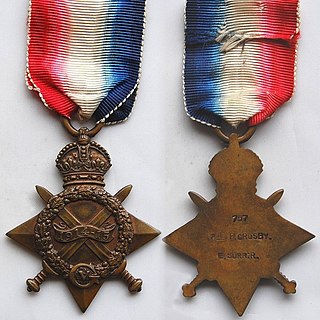 W
WThe 1914–15 Star is a campaign medal of the British Empire which was awarded to officers and men of British and Imperial forces who served in any theatre of the First World War against the Central European Powers during 1914 and 1915. The medal was never awarded singly and recipients also received the British War Medal and Victory Medal.
 W
WThe 1939–1945 Star is a military campaign medal instituted by the United Kingdom on 8 July 1943 for award to British and Commonwealth forces for service in the Second World War. Two clasps were instituted to be worn on the medal ribbon, Battle of Britain and Bomber Command.
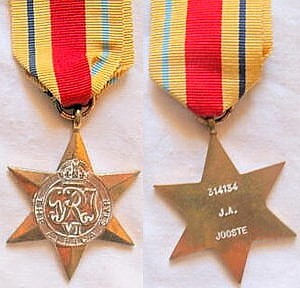 W
WThe Africa Star is a military campaign medal, instituted by the United Kingdom on 8 July 1943 for award to British and Commonwealth forces who served in North Africa between 10 June 1940 and 12 May 1943 during the Second World War.
 W
WThe Air Crew Europe Star is a military campaign medal, instituted by the United Kingdom in May 1945 for award to British and Commonwealth air crews who participated in operational flights over Europe from bases in the United Kingdom during the Second World War.
 W
WThe Arctic Star is a military campaign medal instituted by the United Kingdom on 19 December 2012 for award to British Commonwealth forces who served on the Arctic Convoys north of the Arctic Circle, during the Second World War.
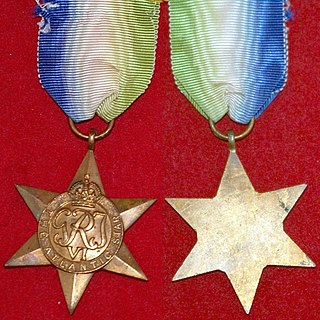 W
WThe Atlantic Star is a military campaign medal, instituted by the United Kingdom in May 1945 for award to British Commonwealth forces who took part in the Battle of the Atlantic, the longest continuous campaign of the Second World War.
 W
WThe British War Medal is a campaign medal of the United Kingdom which was awarded to officers and men of British and Imperial forces for service in the First World War. Two versions of the medal were produced. About 6.5 million were struck in silver and 110,000 in bronze, the latter awarded to, among others, the Chinese, Maltese and Indian Labour Corps.
 W
WThe Burma Star is a military campaign medal, instituted by the United Kingdom in May 1945 for award to British and Commonwealth forces who served in the Burma Campaign from 1941 to 1945, during the Second World War.
 W
WThe Defence Medal is a campaign medal instituted by the United Kingdom in May 1945, to be awarded to citizens of the British Commonwealth for both non-operational military and certain types of civilian war service during the Second World War.
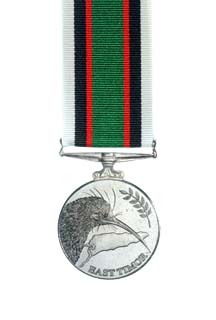 W
WThe East Timor Medal is a New Zealand campaign medal, authorised in 2000, for award to New Zealanders who have served in East Timor from the commencement of the New Zealand involvement in June 1999 until 27 April 2006
 W
WThe France and Germany Star is a military campaign medal, instituted by the United Kingdom in May 1945 for award to British Commonwealth forces who served in France, Belgium, Luxembourg, the Netherlands or Germany and adjacent sea areas between 6 June 1944 and 8 May 1945, during the Second World War.
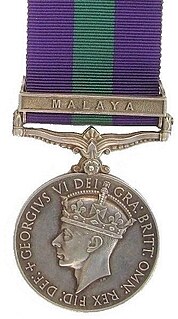 W
WThe General Service Medal was instituted to recognise service in minor Army and Royal Air Force operations for which no separate medal was intended. Local forces, including police, qualified for many of the clasps, as could units of the Indian Army prior to 1947.
 W
WThe General Service Medal, is a campaign medal of the United Kingdom introduced in 1962 to replace both the General Service Medal (1918), as awarded to the Army and RAF, and the Naval General Service Medal (1915). The 1962 GSM was awarded until 2007, when it was replaced by the Operational Service Medal. In 2015 the General Service Medal (2008) was introduced.
 W
WThe International Force East Timor (INTERFET) Medal recognises members of the Australian Defence Force who served for 30 days in East Timor during the INTERFET campaign. The qualifying area comprises East Timor and the sea adjacent to East Timor out to a distance of 12 nautical miles (22 km) from the low water mark.
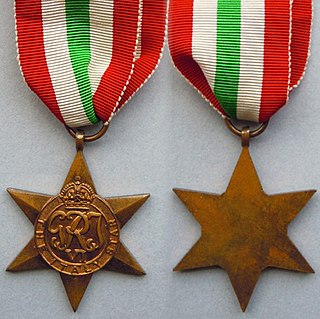 W
WThe Italy Star is a military campaign medal, instituted by the United Kingdom in May 1945 for award to British Commonwealth forces who served in the Italian Campaign from 1943 to 1945, during the Second World War.
 W
WThe King's Badge is a large silver lapel badge authorised by the Ministry of Pensions in the early part of the Second World War and initially issued to servicemen who, as a result of their injuries, had been discharged from active service. It was to be worn only on civilian clothing and by the end of 1941 over 8,000 had been awarded.
 W
WThe Korea Medal, sometimes referred to as the Queen's Korea Medal to distinguish it from the United Nations Service Medal, is a campaign medal created in 1951 to recognize troops from Australia, Canada, New Zealand, and the United Kingdom who had given either one day's service in an air sortie over Korea, or 28 days service offshore, during the Korean War. The medal was identical in all countries where it was awarded, except for Canada where it contained unique elements. An award distributed across the Commonwealth, the Korea Medal holds a different place in each country's order of precedence for honours.
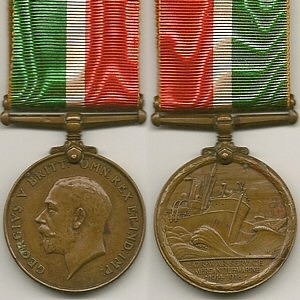 W
WThe Mercantile Marine War Medal was established in 1919 and awarded by the Board of Trade of the United Kingdom to mariners of the British Mercantile Marine for service at sea during the First World War.
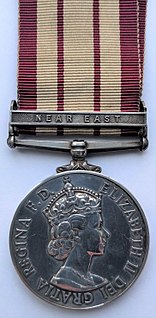 W
WThe Naval General Service Medal was instituted in 1915 to recognise service by the Royal Navy and Royal Marines in minor campaigns that would not otherwise earn a specific campaign medal. The Army/Air Force equivalent was the General Service Medal (1918). Both these medals were replaced by the General Service Medal in 1962.
 W
WThe New Zealand General Service Medal 1992 (Non-Warlike) is a New Zealand campaign medal, authorised in 1992, for award to New Zealanders who have served in peacekeeping operations for which no separate UN medal was issued.
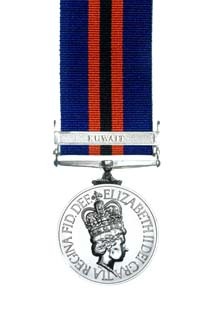 W
WThe New Zealand General Service Medal 1992 (Warlike) is a New Zealand campaign medal, authorised in 1992, for award to New Zealanders who have served in warlike operations for which no separate New Zealand or British Commonwealth campaign medal was issued.
 W
WThe New Zealand General Service Medal 2002 (Afghanistan) is a campaign medal of New Zealand that recognizes service in the War in Afghanistan. The Queen of New Zealand authorized the creation of a new General Service Medal for the recognition of service taking place after December 2001 with a royal warrant on 23 July 2002. Regulations to establish the NZGSM 2002 (Afghanistan) were published 16 January 2003.
 W
WThe New Zealand General Service Medal 2002 (Counter-Piracy) is a New Zealand campaign medal for service in counter-piracy operations in an area centred on the Arabian Sea. The New Zealand General Service Medal 2002 was established by royal warrant to recognize service since 2000. The NZGSM 2002 (Counter-Piracy) was authorized by regulation on 27 March 2015. To qualify for this medal personnel must serve thirty days in an operational area as a member of a New Zealand Government contribution to a force undertaking counter-piracy operations. Only service on or after 1 January 2009 qualifies. Outside the Arabian Sea other areas of operation include the Gulf of Aden, the Western Indian Ocean, and off the coasts of Somalia, Yemen, and Oman. The earliest large deployment of New Zealand Forces was when HMNZS Te Mana served with Combined Task Force 151 and Operation Ocean Shield from November 2013 to February 2014.
 W
WThe New Zealand General Service Medal 2002 is a New Zealand campaign medal for service in the Middle East since 7 December 2014.
 W
WThe New Zealand General Service Medal 2002 was a New Zealand campaign medal for service in the Iraq.
 W
WThe New Zealand General Service Medal 2002 is a New Zealand campaign medal for service in the land territory, airspace, and territorial sea of the country of Iraq since 4 November 2014.
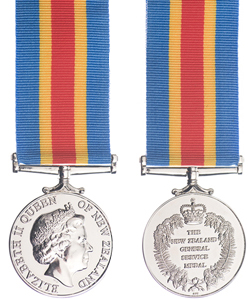 W
WThe New Zealand General Service Medal 2002 (Korea) is a New Zealand campaign medal for service in Korea. The New Zealand General Service Medal 2002 was established by royal warrant to recognize service since 2000. The NZGSM 2002 (Korea) was authorized by regulation on 5 September 2008. To qualify for this medal personnel must serve thirty days in the Republic of Korea with the United Nations Command Military Armistice Commission (UNCMAC) or the United Nations Command Honour Guard Company. Only service since 1 January 2001 qualifies. This medal replaces the award of the New Zealand General Service Medal 1992 (Non-Warlike) with the Korea 1958-2000 clasp.
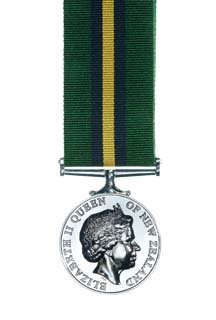 W
WThe New Zealand General Service Medal 2002 was a New Zealand campaign medal for service in the Solomon Islands. The medal was awarded for service during Operation Purple Haze 1 and 2, Operation Zephyr, and the International Peace Monitoring Team from 2000 to 2002 and with the Regional Assistance Mission to Solomon Islands (RAMSI) from 2003 to 2013.
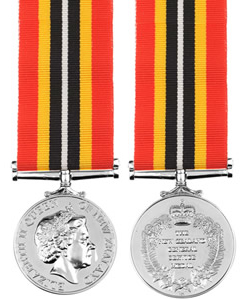 W
WThe New Zealand General Service Medal 2002 (Timor-Leste) is a New Zealand campaign medal for service in Timor-Leste during and after the 2006 East Timorese crisis between 28 April 2006 and 31 December 2012.
 W
WThe New Zealand Operational Service Medal (NZOSM) is a New Zealand campaign medal for award to New Zealanders who have served on operations since 3 September 1945. Eligibility for the NZ OSM commences the day after the final eligibility date for the 1939 - 45 New Zealand War Service Medal. The medal was instituted in 2002 to provide specific New Zealand recognition for operational service. It is awarded in addition to any New Zealand, Commonwealth or foreign campaign medal. It is awarded once only to an individual, regardless of how many times he or she has deployed on operations.
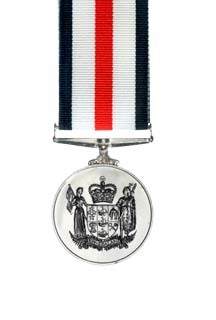 W
WThe New Zealand Service Medal 1946–1949 is a New Zealand campaign medal for service in Occupied Japan at the end of World War II.
 W
WThe New Zealand Special Service Medal (NZSSM) was established by royal warrant by Elizabeth II, Queen of New Zealand on 23 July 2002. The medal serves to recognize military service that would not otherwise be recognized by a Campaign medal.
 W
WThe New Zealand War Medal was a campaign medal authorised in 1869 to be awarded to Imperial and Colonial troops involved in the New Zealand Wars of 1845–47 and 1860–66. The New Zealand Wars were previously known as the Māori Wars, Anglo-Māori Wars or Land Wars.
 W
WThe New Zealand War Service Medal (NZWSM) was a New Zealand campaign medal for service in World War II.
 W
WThe Pacific Star is a military campaign medal instituted by the United Kingdom in May 1945 for award to British and Commonwealth forces who served in the Pacific Campaign from 1941 to 1945, during the Second World War.
 W
WThe Rhodesia Medal was initiated by the British Government in consultation with Australia, New Zealand, Fiji and Kenya, whose forces took part in Operation AGILA,. The role of the multi-national force was to keep peace between 22,000 guerrilla fighters and the Rhodesian forces during the ceasefire and run-up to the 1980 elections.
 W
WThe Victory Medal is a United Kingdom and British Empire First World War campaign medal.
 W
WThe Vietnam Medal was a joint Australian and New Zealand campaign medal awarded for service in the Vietnam War.
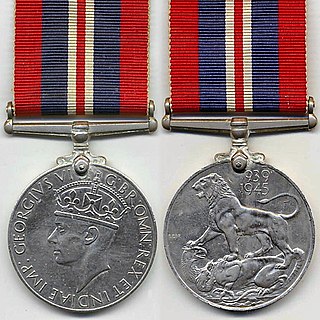 W
WThe War Medal 1939–1945 is a campaign medal which was instituted by the United Kingdom on 16 August 1945, for award to citizens of the British Commonwealth who had served full-time in the Armed Forces or the Merchant Navy for at least 28 days between 3 September 1939 and 2 September 1945.